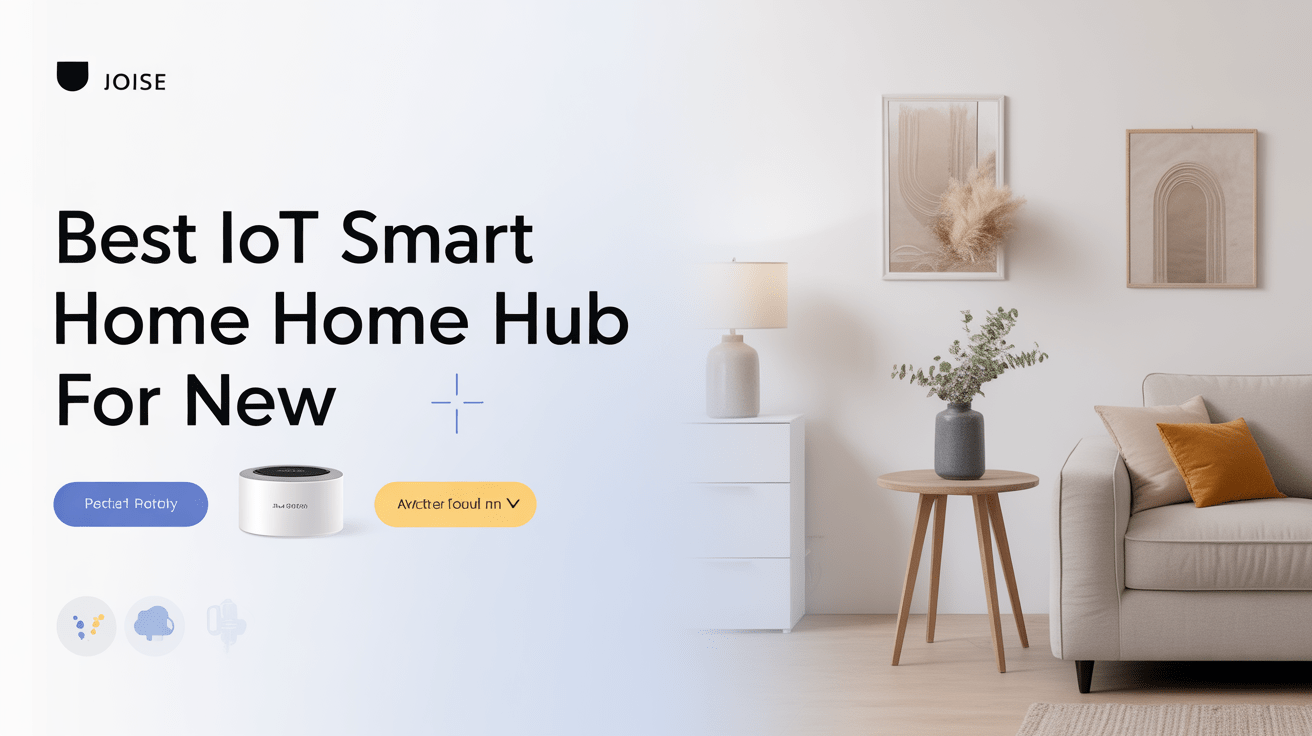
Best iot Smart Home Hub for New Homeowners: An Engineer’s Deep Dive
As smart home technologies surge, new homeowners face a critical question: which IoT smart home hub will deliver seamless integration, robust security, and future-proof extensibility? Selecting the best IoT smart home hub requires deep technical insight into protocols, hardware, software ecosystems, security paradigms, and performance benchmarks. This thorough investigative analysis cuts past marketing hype to evaluate the core architecture and engineering principles behind leading smart hubs, tailored for those entering the smart home era for the first time.
Understanding the Role of an IoT Smart Home Hub in Modern Residences
The smart home hub acts as the central nervous system in an IoT deployment within a residence. It orchestrates device communication,automations,and data flow between diverse smart sensors,actuators,and cloud services.
Core Functions of Smart Home Hubs
- Device Aggregation: Connecting and managing devices spanning Zigbee, Z-Wave, Wi-Fi, Bluetooth LE, Thread, and proprietary protocols.
- data Processing and Automation: Running local logic or cloud-based scripts to trigger automations like turning on lights or adjusting thermostats.
- Gateway and Protocol Translation: Translating between different wireless protocols and ensuring interoperability.
- Security Enforcement: Protecting communication channels and sensitive user data.
- User Interface Provisioning: Supplying control dashboards, mobile apps, and voice assistant integrations.
Why New Homeowners Need a Smart hub
Unlike single-purpose smart devices, a hub consolidates control, simplifies onboarding, and future-proofs the smart home by supporting incremental device additions. For new homeowners, a hub mitigates complexity and fosters system longevity, avoiding vendor lock-ins or fragmented environments.
Common Pitfalls Without a Dedicated Hub
- Fragmented control apps leading to user frustration.
- Interoperability challenges from protocol divergences.
- Inferior security posture due to insecure direct device connections.
- Limited automation scope and scalability.
Evaluating Connectivity Protocols: The Backbone of IoT Smart Home Hubs
Connectivity protocols determine device compatibility, network robustness, range, and energy consumption. Choosing a hub with a broad and future-ready protocol stack is key.
Zigbee vs. Z-Wave vs. Thread: Protocol Strengths and Use Cases
Zigbee operates on 2.4 GHz, offers mesh networking, and is widely adopted for lighting and sensor devices. requesting low latency and decent bandwidth, Zigbee is favored for responsive smart lighting.
Z-Wave is a sub-GHz protocol (typically 908 MHz in US) with excellent wall penetration, ideal for home security sensors and locks. Its simpler protocol stack ensures solid interoperability, but device availability is narrower.
Thread is a newer IPv6-based mesh protocol designed specifically for low-power IoT, providing robust local connectivity with internet integration via border routers.
Complementary Wireless Technologies
- Wi-Fi: High bandwidth but higher power consumption; supports cameras, voice assistants.
- Bluetooth LE: Ideal for proximity sensors and simplifies device onboarding.
- Power Line Communication (PLC): Rare but useful in homes with wired electrical infrastructure.
Checklist for Protocol Support in a Smart Hub
- Supports at least Zigbee and Z-Wave for maximum device coverage.
- Emerging support for Thread is desirable for future-proofing.
- Wi-Fi and Bluetooth LE for direct internet and accessory device integration.
- Capability for firmware updates over-the-air (OTA) for device compatibility expansions.
Architectural Components of Leading IoT Smart Home Hubs
Dissecting the technical anatomy reveals distinctions in processing power, security modules, and integrated radios impact performance and extensibility.
processing and Storage Requirements
Modern smart hubs embed multi-core ARM processors and sufficient RAM (512MB-2GB) to handle local automations, reduce cloud dependency, and enhance responsiveness.
Security Modules and Trusted Execution environments
hardware security enclaves or Trusted Platform Modules (TPM) safeguard cryptographic keys and execute secure boot sequences, crucial for preventing device compromise.
Multi-Radio Integration
SoCs uniting Zigbee,Z-Wave,Wi-fi,Thread,and BLE radios minimize hub footprint while ensuring seamless cross-protocol communication.
Power design and Reliability
Consideration for uninterruptible power supply (UPS) or battery backup increases hub uptime, especially for security-critical automations.
“rely on tools for flexibility and community-driven innovation-a true game-changer!”
Software Ecosystem: Operating Systems, Middleware, and apis
The software stack defines device integration capabilities, extensibility, and developer friendliness. Analyze hubs on OS, SDK availability, and open-source vs. proprietary middleware layers.
Embedded Operating Systems vs. Containerized Platforms
Some hubs run customized Linux builds or RTOS with limited user access, whereas others embrace containerized environments (Docker, balenaOS) permitting third-party app development.
Middleware and Device Drivers
Middleware abstracts diverse protocols, presenting unified APIs. Quality middleware accelerates device onboarding and manages firmware update orchestration smoothly.
API Ecosystems and Developer Support
- restful APIs, MQTT brokers, and WebSocket interfaces enable flexible integration.
- Open developer forums and accessible SDKs empower DIY developers and startups.
- Cloud integration support (AWS IoT Core, Azure IoT Hub, Google Cloud IoT) helps scale advanced automations and analytics solutions.
Security Paradigms for Smart Home Hubs: Threats and defenses
Given their central role, smart home hubs are prime targets for attackers. Engineers must architect multi-layered defenses.
Common Attack Vectors
- Unauthenticated device pairing/exploitation.
- Man-in-the-middle attacks on wireless protocols.
- cloud account credential compromise.
- Firmware manipulation or injection attacks.
Security Best Practices
- Strong multi-factor user authentication and OAuth 2.0 integration.
- End-to-end encryption of all communications including Zigbee/Z-Wave.
- Secure firmware signing and verified update processes.
- Network segmentation and anomaly detection via hub analytics.
Privacy Considerations
Hubs should minimize cloud-dependency for sensitive data, offer local data processing options, and provide transparent user data policies compliant with GDPR and CCPA.
Top IoT Smart Home Hubs: Comparative Engineering Analysis
Here we benchmark leading hubs on essential engineering dimensions relevant to new homeowners.
Samsung SmartThings Hub
- Supports Zigbee, Z-Wave, Wi-Fi, and BLE.
- Strong cloud and local automations via Groovy-based smartapps and WebCore.
- Proprietary but rich API ecosystem; integrated voice assistant support.
- Security via AES encryption, though some cloud dependency.
Hubitat Elevation Hub
- Supports Zigbee, Z-Wave, and LAN devices but no Wi-Fi radio.
- Local automation engine with powerful Rule machine UI.
- Privacy-focused; minimal cloud dependency.
- Active developer community and app ecosystem.
Apple HomePod Mini
- Focus on Thread and Wi-Fi; no Zigbee/Z-Wave.
- Seamless integration with apple HomeKit ecosystem.
- Strong local encryption and privacy safeguards.
- Best for Apple-centric homeowners.
Amazon Echo Plus
- Built-in zigbee hub plus Alexa voice assistant.
- Cloud-driven automations with growing Local Voice Control.
- Strong ecosystem but privacy concerns about cloud usage.
rely on tools for flexibility and community-driven innovation-a true game-changer!
Integration Strategies for seamless Smart Home Deployment
Effectively integrating multiple devices requires solid planning around device compatibility, network design, and automation logic.
Device Finding and Onboarding Automation
Utilize hubs supporting Bluetooth LE or QR code scanning for frictionless onboarding. DHCP reservation and mDNS assist in stable network addressing.
Network Segmentation and performance Optimization
segment iot traffic on a dedicated VLAN or SSID to minimize congestion and isolate security risks.Ensure your hub supports band steering and multiple SSIDs.
Automation Workflow Design
Use hubs exposing visual rule-building interfaces or scripting SDKs supporting event-driven triggers (motion, voice command, schedule) and complex conditions.
Benchmarks: Performance Metrics Impacting smart Home Experience
Latency, reliability, and throughput directly impact user satisfaction and automation smoothness.
Latency (P95) Considerations
Smart home actions require latencies below 200 ms to feel instantaneous, especially for voice and lighting control.
throughput and Scalability
Evaluate hubs by their maximum connected devices and message throughput capabilities to future-proof setups.
Reliability KPIs
Measure uptime, auto-recovery mechanisms, and fail-safe states on power/network outages for critical devices like locks and alarms.
Future Directions: Smart Home Hub Evolution & Developer Opportunities
Emergence of AI-Driven Local Automation
Future hubs will increasingly embed AI inferencing engines for predictive automations, anomaly detection, and personalized user experiences without cloud latency.
Mesh Network Enhancements
Thread and emerging protocols like Matter promise seamless secure interoperability across manufacturers,easing integration woes.
Developer Ecosystems and Open Platforms
Open-source hubs and platforms such as Home Assistant foster innovation and customization beyond vendor constraints.
Energy Efficiency & Sustainability
Optimizing power consumption and enabling green home scenarios through smart device coordination will be pivotal.
Checklist for Selecting the Best IoT Smart Home Hub for New Homeowners
- Multi-Protocol Support: Must handle Zigbee, Z-Wave, Wi-fi, and Thread to cover broad device ecosystems.
- Local Automation Capability: prioritize hubs with robust local processing to reduce cloud reliance.
- Strong Security Measures: End-to-end encryption, secure boot, and regular OTA updates.
- Developer and Community Support: Access to APIs, SDKs, and active forums.
- Reliable Performance Metrics: Low latency, high uptime, and scalability.
- User Experience: Intuitive onboarding,clean user interfaces,and voice assistant integration.
- extensibility: Modular firmware and potential to incorporate new protocols or devices.
Transforming New Homes into Smart Homes: Final Perspectives
For new homeowners venturing into smart home tech, the hub is the vital linchpin binding varying devices into a cohesive intelligent environment. This engineer’s deep dive reveals that no single hub fits all, but those blending comprehensive protocol support, local autonomy, stringent security, and open ecosystems lead the pack.
With IoT technology advancing swiftly, adopting a flexible hub platform equipped for upward growth is the cornerstone of a truly future-ready smart home. Intelligent, secure, highly interoperable hubs like Samsung SmartThings,Hubitat Elevation, and emergent open systems are poised to empower new homeowners in shaping smart living at scale.





